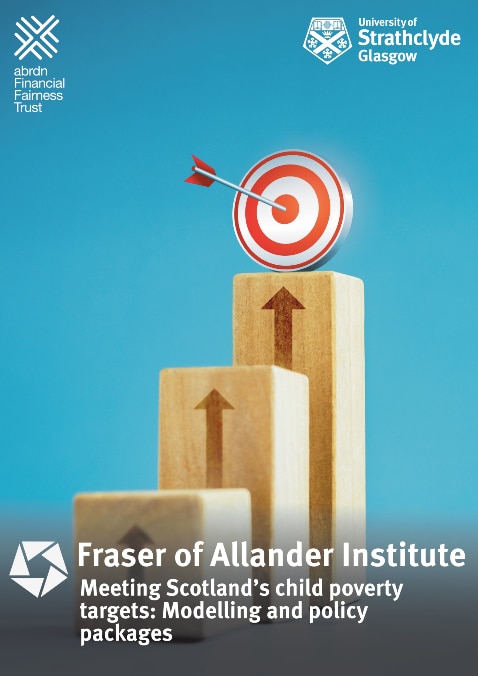When governments set targets, policy makers need to draw on modelling tools to ensure they are putting in place the right policy interventions at the scale required to meet the challenge at hand.
In 2017, the Child Poverty (Scotland) Act set statutory interim targets for child poverty, due in 2023/24, final targets due in 2030/31. There are four measures that have targets: relative poverty, absolute poverty, low income and material deprivation, and persistent poverty. For instance, the statutory target for relative poverty is less than 18% by 2023/24 and less than 10% by 2030/31.
In the 2022 child poverty delivery plan, the Scottish Government used microsimulation modelling to show how their policies would contribute to meeting the targets up to 2025/26. In February 2024, the Scottish Government provided an update for the years up to 2026/27.
This report provides an updated set of modelled estimates that take the time horizon out to 2030/31, the year by which the statutory targets must be met. We explore how Scottish Government announcements since February 2024 have helped with progress towards the targets and what else might be required.
Our modelling shows that meeting the targets is still feasible but will require sizeable additional investment beyond what is currently proposed. While the policy packages we model are far from the only path to reaching the targets, they demonstrate the scale of the challenge to be met.
We estimate that, based on policy currently in place and no other policy changes, the gap between current poverty levels and the statutory target for relative poverty is around 11 percentage points.
The recently announced decision to mitigate the two-child limit in Scotland will reduce the gap to 10 percentage points.
If the Scottish Government is able to maximize levers to support parents into work and to increase their hours of work and pay, this will reduce child poverty by a further 2.8 percentage points. Of this, 1.2 percentage points come from improving rates of pay for working parents, while the remainder comes from an increase to parental employment. Increasing hours worked for parents who are already in work makes very little difference, mainly because working parents already have quite high hours.
Given the levers available to the Scottish Government, additional social security interventions will likely be required to close the remaining gap of 7.2 percentage points.
These social security interventions could be a combination of changes to better cover housing costs through existing benefits, premia applied to other means tested benefits for certain groups, or an increase in an existing payment such as the Scottish Child Payment (SCP). Other potential levers, like rent controls or an increase in the stock of social housing, are left for further research.
We explore options and conclude that increases to SCP are the most effective tool available to the Scottish Government. We find that, in addition to the other policies modelled, increasing SCP to £150 for everyone, or to £115 for all children plus a per-household premium of £50 for some priority households, would be the size of investment needed to meet the 2030/31 targets. We also model an intermediate amount of £40 per week, per child for SCP, as well as the £50 premium on its own. Our analysis highlights that a more targeted approach to SCP where some priority households receive premia may make progress towards the child poverty targets at a lower cost.
The cumulative cost of the policies we have modelled is between £4.6 and 4.9 billion in current prices. This is a substantial investment, equivalent to about 75-80% of the budget for devolved benefits in Scotland in 2024/25. About 60% of the cost comes from the childcare and afterschool care expansions that would be required to support greater parental employment. We highlight that increasing spending on the Scottish Child Payment is more cost-effective, achieving a greater impact on child poverty at a lower cost.
abrdn Financial Fairness Trust has supported this project as part of its mission to contribute towards strategic change which improves financial well-being in the UK. The Trust funds research, policy work and campaigning activities to tackle financial problems and improve living standards for people on low-to-middle incomes in the UK. It is an independent charitable foundation registered in Scotland (SC040877).
Authors
Hannah is a Fellow at the Fraser of Allander Institute. She specialises in applied social policy analysis with a focus on social security, poverty and inequality, labour supply, and immigration.
Chirsty is a Knowledge Exchange Associate at the Fraser of Allander Institute where she primarily works on projects related to employment and inequality.
Emma Congreve is Principal Knowledge Exchange Fellow and Deputy Director at the Fraser of Allander Institute. Emma's work at the Institute is focussed on policy analysis, covering a wide range of areas of social and economic policy. Emma is an experienced economist and has previously held roles as a senior economist at the Joseph Rowntree Foundation and as an economic adviser within the Scottish Government.



